Drygalski Ice Tongue

The Drygalski Ice Tongue or Drygalski Barrier or Drygalski Glacier Tongue is a glacier in Antarctica, located on the Scott Coast, in the northern McMurdo Sound of Antarctica's Ross Dependency, 240 kilometres (150 miles) north of Ross Island. The ice tongue is located at 75°24′S 163°30′E / 75.400°S 163.500°E. Drygalski Ice Tongue, being a stable feature by the standards of Antarctica's icefloes, stretches 70 kilometres out to sea from the David Glacier, reaching the sea from a valley in the Prince Albert Mountains of Victoria Land. Drygalski Ice Tongue ranges from 9 to 15 miles (14 to 24 km) wide.
Captain Robert Falcon Scott, leader of the British National Antarctic Expedition (BrNAE) (1901-1904), discovered Drygalski Ice Tongue in January 1902 and named it for Prof. Erich von Drygalski, a contemporary German explorer then in Antarctica. Drygalski Ice Tongue became well established by the name Drygalski Ice Tongue prior to initiation of systematic application of common specific names to a glacier and its glacier tongue. Although this feature is a glacier tongue, the generic term ice tongue has been retained in the name to reduce ambiguity.
Drygalski Ice Tongue is thought to be at least 4,000 years old.
On March-April 2005, a 3,000 km² iceberg designated B-15A collided with the ice tongue breaking off two pieces, each one with a surface of about 70 km². This iceberg is a remnant of Iceberg B-15, which calved from the Ross Ice Shelf in 2000. Scientists are also concerned for several penguin colonies which have been isolated from the open sea by the two large bodies of ice.
At the end of March 2006, another iceberg coming from Ross Ice Shelf, named C-16, collided with the ice tongue breaking off a large additional piece (more than 100 km²).
